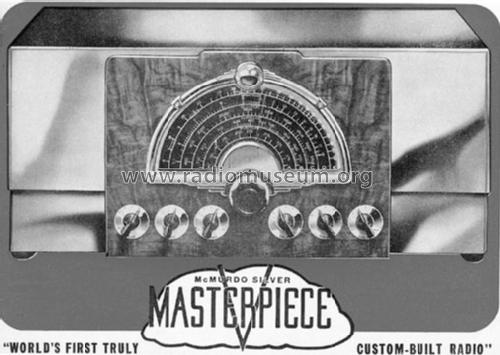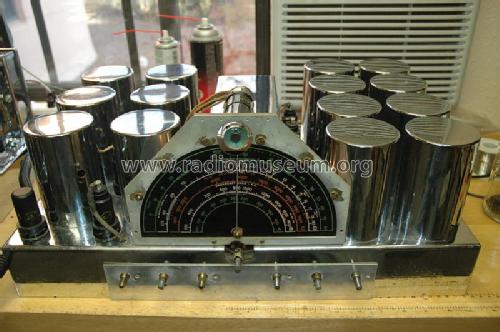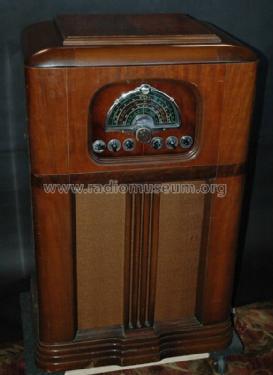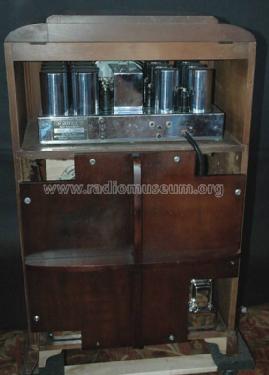Masterpiece V (5)
McMurdo Silver, Inc.(pre WW2); Chicago
- Country
- United States of America (USA)
- Manufacturer / Brand
- McMurdo Silver, Inc.(pre WW2); Chicago
- Year
- 1936
- Category
- Broadcast Receiver - or past WW2 Tuner
- Radiomuseum.org ID
- 114350
Click on the schematic thumbnail to request the schematic as a free document.
- Number of Tubes
- 20
- Main principle
- Superhet with RF-stage
- Wave bands
- Broadcast, Long Wave and more than two Short Wave bands.
- Power type and voltage
- Alternating Current supply (AC)
- Loudspeaker
- 3 Loudspeakers
- Material
- Metal case
- from Radiomuseum.org
- Model: Masterpiece V - McMurdo Silver, Inc.pre WW2;
- Shape
- Chassis only or for «building in»
- Notes
- The McMurdo Silver Masterpiece V
In 1936 another new model appeared, the Masterpiece V. A complete re-design, in addition to the use of metal tubes were incorporated, the 20 tube set now had a larger and more impressive dial and front panel. The much-refined circuit used two 6K7's in the RF stages, a 6L7 mixer, a 6J7 oscillator, three 6K7's in the IF, a 6Q7 second detector and first audio, a 6K7 and 6H6 as AVC amplifier and rectifier, two 6C5's in push-pull driving two metal 6L6's in the output, and two 5Z3 rectifiers. In addition, the receiver had a volume-expander using a 6L7, 6C5 and a 6H6. A 6G5 Tuning-eye tube replaced the meter used in previous models. This was McMurdo Silver's first major attempt to capture some of Scott's high-end market.
The IF bandwidth control retained the system used in the previous model; three stages for maximum selectivity, and just one for high-fidelity local reception.
Bass and treble controls were used, along with the new volume expander control. The audio system was now resistance-coupled, eliminating the interstage transformer which was a feature of earlier designs. Bass and treble controls are cut only but bass boost is accomplished in the volume control circuit. The 25Watt power amplifier drives two Jensen A12 electro-dynamic speaker mounted in a lined infinite baffle speaker enclosure for superior bass response.
A phono jack was provided so that the audio signal from the radio and phono inputs could be fed to a separate amplifier, perhaps for earphone or public address use. Plugging into this jack disabled the output amplifiers.
- Source of data
- -- Collector info (Sammler)
- Author
- Model page created by Konrad Birkner † 12.08.2014. See "Data change" for further contributors.
- Other Models
-
Here you find 40 models, 38 with images and 8 with schematics for wireless sets etc. In French: TSF for Télégraphie sans fil.
All listed radios etc. from McMurdo Silver, Inc.(pre WW2); Chicago







